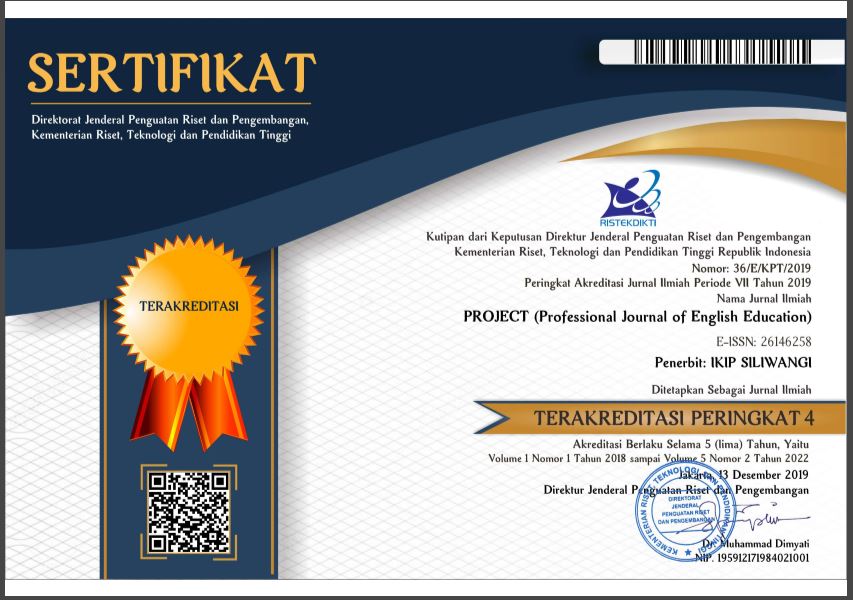FIGURATIVE LANGUAGE USED IN JENNIE FROM BLACKPINK INTERVIEW WITH ELLE MAGAZINE
Abstract
Jennie, a popular star with millions of fans, used fictional language in an exclusive interview with ELLE magazine. She used figurative language to attract attention, bring personal stories to life, and create profound impressions. Jennie's unique speaking style blended fictional meaning and authentic self-expression, solidifying her position as a modern pop icon. This study used qualitative-descriptive research to accurately describe the object and explain the data in a systematic and thorough manner. The data for this study came from Jennie from Blackpink's YouTube channel, Elle. The documentary technique was used to collect data, which was applied to written or visual materials in order to identify certain qualities of the material, such as textbooks, speeches, ads, or any of these. Based on data taken by researchers, they found that there were 25 sentences, 5 of which contained figurative language and 20 of which did not contain it. In 5 sentences containing figurative language, there were 1 sentences using hyperbole, 3 with metaphors and 1 with repetitions. Jennie effectively used metaphors, personification, idioms, and repetitions to convey her emotions and reality in an interview, creating captivating images and a concise message.
References
Colston, H. L. (1997). Salting a wound or sugaring a pill: The pragmatic functions of ironic criticism. Discourse processes, 23(1), 25-45.
El-Samir, S. F. (2014). Politeness: A Socio-Pragmatic Study. Journal of the College of Languages (JCL), (28), 1-37.
Fitria, T. N. (2018). Figurative language used in one direction’s album entitled up all night. ELITE, 5(01).
Larasati, D. (2018). Globalization on culture and identity: Pengaruh dan eksistensi hallyu (korean-wave) versus westernisasi di indonesia. Jurnal Hubungan Internasional, 11(1), 109-120.
Liontas, J. I. (2018). Exploring figurative language across the curriculum. The TESOL Encyclopedia of English Language Teaching, 1-9.
Lukmana, D., Rosa, R. N., & Marlina, L. (2019). An analysis of metaphor in the lyrics of selected Minangkabaunese songs. English Language and Literature, 8(3).
Meyrina, P. P. (2015). Kajian Semiotika Perubahan Maskot Majalah Anak-Anak ‘Bobo’Pada Tahun 1973, 2007, Dan 2009 (Doctoral dissertation, Institut Seni Indonesia Yogyakarta).
Moleong, L. J. (2017). Qualitative Research Methods, 36th printing, Bandung: PT. Teen Rosdakarya Offset.
Muhammad, F., Hidayat, D. N., & Alek, A. (2021). An analysis of figurative language in Maroon 5–Nobody’s Love song lyrics. Wanastra: Jurnal Bahasa dan Sastra, 13(1), 32-38.
Paul, R. (2020). Language disorders. In Handbook of clinical neurology (Vol. 174, pp. 21-35). Elsevier.
Perrine, L. (1974). Structure, sound, and sense. Harcoury Brace Jovanovich: Inc. New York.
Ratna, A. P. (2017). An analysis of figurative language found in Katy Perry’s song entitled “Firework”. Lingua Scientia, 24(2), 45-58.
Rocha, P. I., Caldeira de Oliveira, J. H., & Giraldi, J. D. M. E. (2020). Marketing communications via celebrity endorsement: an integrative review. Benchmarking: An International Journal, 27(7), 2233-2259.
Saragih, D. Y. (2021). An analysis of metaphor in batak toba song lyrics (mother love’s theme). Budapest International Research and Critics Institute-Journal (BIRCI-Journal), 4(2), 2013-2021.
Setiawati, W., & Maryani, M. (2018). An Analysis Of Figurative Language In Taylor Swift’ s Song Lyrics. PROJECT (Professional Journal of English Education), 1(3), 261-268.
Syafitri, D., & Marlinton, M. (2018). An analysis of figurative language used in Edgar Allan Poe’s poems. Linguistic, English Education and Art (LEEA) Journal, 2(1), 43-59.
Syahrina, A. (2019). A stylistic study of figurative language in Katy Perry’s Song lyrics from Witness Album (Bachelor's thesis, Fakultas Adab dan Humaniora UIN Syarif Hidayatullah Jakarta).
Tofani, A. Z. (2023). Weverse Sebagai Sarana Komunikasi Fans Dengan Idol (Studi Pada Interaksi Seventeen Dan Carat). Prosiding Konferensi Nasional Sosial dan Politik (KONASPOL), 1, 349-358.
Downloads
Published
Issue
Section
License

This work is licensed under a Creative Commons Attribution-ShareAlike 4.0 International License.




